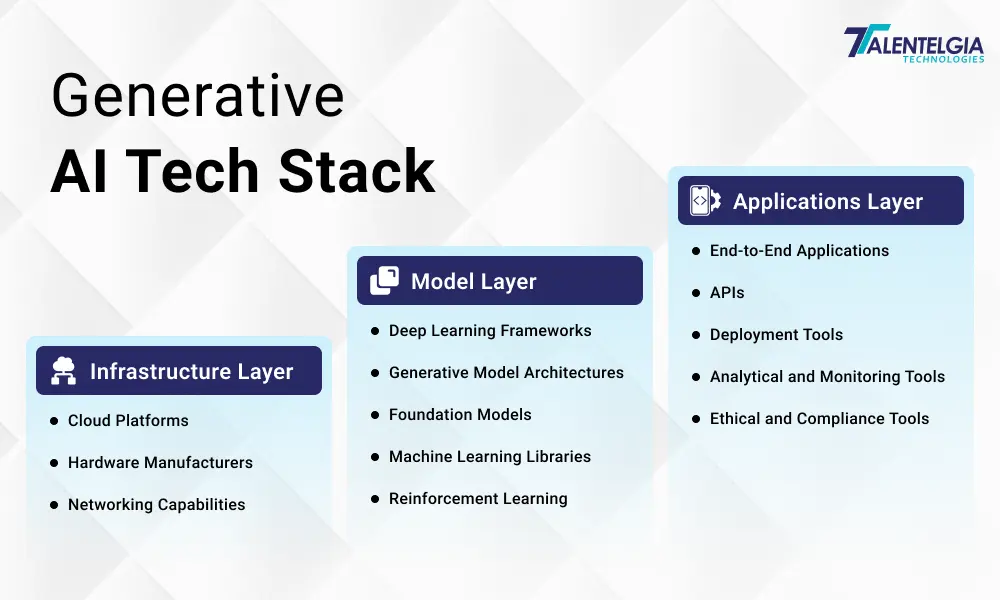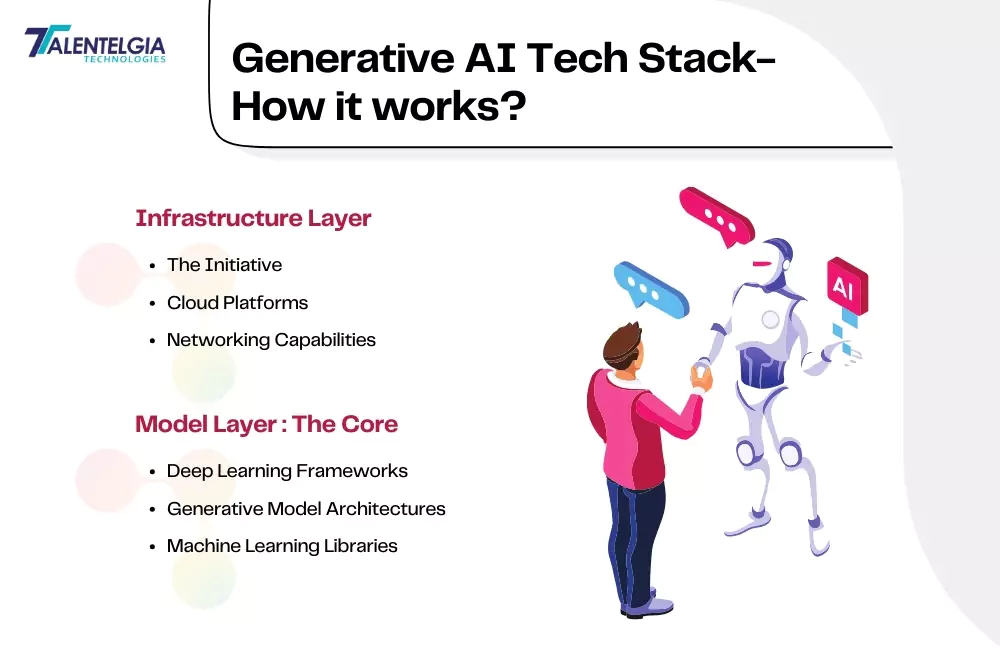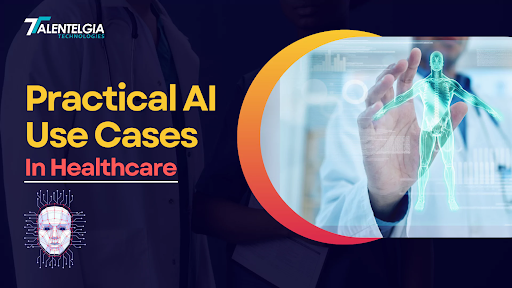Have you ever pondered the remarkable ability of generative AI to create complete articles, compose music, or generate images from nothing? Central to this technological wonder is the Generative AI Tech Stack, a complex collection of tools and technologies that enable machines to learn from extensive datasets and, beyond that, to innovate and produce original content.
Generative AI works by learning from huge amounts of data through neural networks. Once trained, these models can make predictions or decisions based on new data. What sets them apart is their ability to create—be it meaningful text or even images from simple descriptions.
Take ChatGPT, for example. It’s transformed how we interact with technology, answering questions and even composing essays like a human. Similarly, Google’s Gemini is pushing boundaries in content creation.
Expert Generative AI
Development. Cutting-edge generative AI solutions
devilerd by top AI developers, trusted
in 20+ countries.

Understanding this technology is crucial as we enter a new AI era. It’s not just about the algorithms and data; it’s about leveraging these tools creatively. Industries like marketing, entertainment, and education are likely to see AI-generated content becoming the norm.
Exploring generative AI is a fascinating journey full of possibilities. Starting with basics like neural networks, we uncover its potential to redefine what’s possible with AI.
What is Generative AI Tech Stack?

Generative AI refers to artificial intelligence systems that can create new content, ideas, or solutions by themselves, without being explicitly programmed to do so. Different from the old AI which is used to analyse or categorize information from existing structured data, generative AI creates original content that is beyond the existing data. This means it can create everything from realistic pictures and well-written pieces of text to complex programming code. Achieving these amazing results is only possible by using a set of advanced technologies together, known as the Generative AI Tech Stack. Understanding this stack is crucial. It helps to learn about the limits and the potential of generative AI.
Generative AI technology is a multilayered architecture, each self-motivating to fulfill a specific purpose, and simultaneously collaborate with the other layers to support the generation of new content. These layers consist of the Infrastructure layer, Model Layer, and the Applications layer. From the given list, let us study the ones in depth.
How Generative AI Tech Stack Works and What It Contains?

Generative AI is probably the biggest transformational factor that can be used to increase creativity and innovation on the part of humans. A multi-faceted technology stack called Generative AI Tech Stack that constitutes a variety of techniques is what lies at the core of this revolution.
Through this, the stack becomes neither just the backbone nor the brain, muscle, and heart of generative AI, but the entire neural system, from basic computations to the implantation of innovative applications in an effortless integration with the user.
Let’s learn more about it.
Infrastructure Layer: The Initiative
The Infrastructure Layer consists of the base of the stack. This level offers the required computational power and needed resources for the training and running of these generative models. It consists of two main components:
- Cloud Platforms: While cloud computing platforms like Google Cloud Platform (GCP), Amazon Web Services (AWS), and Microsoft Azure have gained a lot of popularity, they are also very important. They provide scalable and on-demand access to computing resources, thus, it becomes possible to have the large computation task of training generative AI models. These platforms also provide a host of AI-specific tools, services, and AI cloud solutions, which accomplish the goal of making the whole development process simply easy.
- Hardware Manufacturers: Hardware is no less important than software, top-class companies such as NVIDIA and AMD are pioneers in designing GPUs made specifically for gaming. These GPUs are customized for massively parallel processing; after all, these calculations are rather demanding and require more than a single processor. With the ever-increasing efficiency and power of these GPUs, AI has gotten the strength to provide the leading edge in generative AI capabilities.
- Networking Capabilities: In addition to this, the fast operationality of the generative AI needs a strong connection with a high-performance network. Cloud migration extenuates the importance of data transmission between and inside different components of a tech stack and guarantees effective communication among cloud resources. The role of the latest network technologies, provided by cloud suppliers, is very profound in diminishing the delays and improving the generative AI operations.
Data Insights? Get in touch with our team to
integrate ChatGPT with
Power BI.

Model Layer: The Core
Central to the Generative AI Tech Stack is the Model Layer. This layer is a key component that is made up of algorithms and models that are equipped to produce new data.
- Deep Learning Frameworks – To begin with, there are deep neural networking frameworks: TensorFlow and PyTorch among others. These are named environments with tools and resources that let developers build, train, and deploy neural networks. These frameworks have a great impact on the creation of generative models, bringing in the balance between the flexibility of use and the ease of work.
- Generative Model Architectures – This involves not only different types of neural network architectures such as Generative Adversarial Networks (GANs), Variational Autoencoders (VAEs), and transformers, but also algorithms like attention mechanisms and backpropagation. GANs have two networks that compete to generate new, realistic images that no one has seen. In general, these architectures act as the brain of the generative AI system, allowing it to learn from huge collections of data and copy the distribution of the input data to produce novel outputs.
- Foundation Models – Generative AI has a recent addition to its list of developments, Foundation Models (FMs). These are comprehensive models that have been trained on vast datasets that cover different data modalities. These models, once trained, can be fine-tuned as per specific tasks they will be used for; therefore, we can have a versatile tool for any generative AI application.
- Machine Learning Libraries– Along with the frameworks, a multitude of machine learning libraries including Scikit-learn, Keras, and others, enrich the Model Layer for the creation of generative models by introducing extra tools and algorithms for our use. This is the library where you find many functions and utilities that simplify complex tasks in such a way that machine learning developers can spend more time on innovation and less on algorithm implementation details.
- Reinforcement Learning– The next aspect of the Model Layer is that they employ reinforcement learning wherein models learn best actions through their trial and error process to reach specific goals. This strategy becomes a real breakthrough, especially in cases where the generative AI agents are put in contact with real-world environments in a real-time manner, such as gaming or robotic applications, that push the boundaries of what generative models can achieve.
Applications Layer: The Interface

The Applications Layer is where the capabilities of generative AI are made tangible by giving the power to the users in the form of practical applications.
- End-to-End Applications – These are groups of programs that are built to prompt generative models to create content. To illustrate, an image generator tool that involves a GAN to produce art from textual descriptions or a content creation tool that leverages a transformer model to write articles are examples.
- APIs – Application Program Interfaces (APIs) are important in the integration of generative models into the existing software or the creation of new applications. APIs essentially act as the intermediaries between the complex and amazing world of generative models and real-world applications, which can be easily accessed by non-specialists.
- Deployment Tools – Various tools and technologies are behind the ushering of generative AI models into the production phase. These tools take care of such things as growth, security, and effectiveness so that applications don’t fail in their intended purpose in the real world.
- Analytical and Monitoring Tools– Along with the deployment of AI apps, we need to have tools for tracking performance and for examining user behavior. Such tools not only guarantee the applicability of AI along with its smooth execution but also provide insights into human engagement with AI-generated content, which in turn could inform future improvements and iterations. This loop is crucial in the development process because it ensures that the AI is improved and the user experience is enhanced.
- Ethical and Compliance Tools– “Great power comes with great responsibility”, so this is a famous quote from Spider-Man. Furthermore, ensuring means to trust in the ethical enactment and the laws and regulations is also becoming important in the Applications Layer. These tools help developers to follow ethical rules, guarantee users’ privacy, and make sure that AI is used appropriately for the benefit of people and not harmful. With this part of the tech stack, it is obvious that the development and deployment of AI in a responsible manner is crucial.
The generative AI tech stack, in simple terms, represents a diverse and empowering ecosystem that provides developers with the ability to develop and test AI applications with AI integration services that can create something entirely new and novel.
FAQs
What Components Constitute the Infrastructure Layer of Generative AI Tech Stack?
The Infrastructure Layer comprises cloud platforms, hardware manufacturers, and networking capabilities. Cloud platforms such as GCP, AWS, and Azure provide scalable computing resources, while hardware manufacturers like NVIDIA and AMD offer specialized GPUs for high-performance processing. Additionally, fast networking capabilities ensure efficient communication within the stack.
What Role Does the Model Layer Play in Generative AI Tech Stack?
Central to the stack, the Model Layer consists of deep learning frameworks, generative model architectures, foundation models, machine learning libraries, and reinforcement learning techniques. These components enable the creation of generative models, allowing AI systems to learn from data and produce novel outputs.
How Does the Applications Layer Utilize Generative AI Capabilities?
The Applications Layer empowers users through end-to-end applications, APIs, deployment tools, and analytical and monitoring tools. These tools facilitate the practical implementation of generative AI, enabling tasks such as content generation, integration into existing software, deployment into production, and monitoring of performance and user behavior.
What Ethical Considerations are Addressed in Generative AI Tech Stack?
Ethical and compliance tools are integrated into the Applications Layer to ensure responsible AI development and deployment. These tools help developers adhere to ethical guidelines, protect user privacy, and comply with laws and regulations. By prioritizing ethical considerations, the tech stack promotes the beneficial and safe use of generative AI for society.
Conclusion
The Generative AI Tech Stack opens the door to a world where human creativity and technology work together to expand the range of opportunities across different industries. These layers start from the basic infrastructure layer, through the intricate model layer, and to the versatile applications layer, and each of them provides the platform for creating the most amazing digital content. The next step in the evolution of generative AI is not only about creating content but also tackling the ethical, environmental, and societal considerations that come with the technology. AI deployment has hugely benefitted from the speed of training using GPUs, the flexibility of Foundation Models, and the ease of integration through APIs, which makes generative AI a technological wonder. But this power also comes with a great responsibility. The ethical issues of AI generative outline the importance of ethical-principled technology development and usage. Finally, the Generative AI Tech Stack is the product of the merging of innovation and creativity, which makes the future digital and creative landscapes limitless. As we continue to explore generative AI, the search for the balance between advancement and ethical responsibility must go on, this will direct generative AI towards a constructive and inclusive future.


 Healthcare App Development Services
Healthcare App Development Services
 Real Estate Web Development Services
Real Estate Web Development Services
 E-Commerce App Development Services
E-Commerce App Development Services E-Commerce Web Development Services
E-Commerce Web Development Services Blockchain E-commerce Development Company
Blockchain E-commerce Development Company
 Fintech App Development Services
Fintech App Development Services Fintech Web Development
Fintech Web Development Blockchain Fintech Development Company
Blockchain Fintech Development Company
 E-Learning App Development Services
E-Learning App Development Services
 Restaurant App Development Company
Restaurant App Development Company
 Mobile Game Development Company
Mobile Game Development Company
 Travel App Development Company
Travel App Development Company
 Automotive Web Design
Automotive Web Design
 AI Traffic Management System
AI Traffic Management System
 AI Inventory Management Software
AI Inventory Management Software
 AI Software Development
AI Software Development  AI Development Company
AI Development Company  AI App Development Services
AI App Development Services  ChatGPT integration services
ChatGPT integration services  AI Integration Services
AI Integration Services  Generative AI Development Services
Generative AI Development Services  Natural Language Processing Company
Natural Language Processing Company Machine Learning Development
Machine Learning Development  Machine learning consulting services
Machine learning consulting services  Blockchain Development
Blockchain Development  Blockchain Software Development
Blockchain Software Development  Smart Contract Development Company
Smart Contract Development Company  NFT Marketplace Development Services
NFT Marketplace Development Services  Asset Tokenization Company
Asset Tokenization Company DeFi Wallet Development Company
DeFi Wallet Development Company Mobile App Development
Mobile App Development  IOS App Development
IOS App Development  Android App Development
Android App Development  Cross-Platform App Development
Cross-Platform App Development  Augmented Reality (AR) App Development
Augmented Reality (AR) App Development  Virtual Reality (VR) App Development
Virtual Reality (VR) App Development  Web App Development
Web App Development  SaaS App Development
SaaS App Development Flutter
Flutter  React Native
React Native  Swift (IOS)
Swift (IOS)  Kotlin (Android)
Kotlin (Android)  Mean Stack Development
Mean Stack Development  AngularJS Development
AngularJS Development  MongoDB Development
MongoDB Development  Nodejs Development
Nodejs Development  Database Development
Database Development Ruby on Rails Development
Ruby on Rails Development Expressjs Development
Expressjs Development  Full Stack Development
Full Stack Development  Web Development Services
Web Development Services  Laravel Development
Laravel Development  LAMP Development
LAMP Development  Custom PHP Development
Custom PHP Development  .Net Development
.Net Development  User Experience Design Services
User Experience Design Services  User Interface Design Services
User Interface Design Services  Automated Testing
Automated Testing  Manual Testing
Manual Testing  Digital Marketing Services
Digital Marketing Services 
 Ride-Sharing And Taxi Services
Ride-Sharing And Taxi Services Food Delivery Services
Food Delivery Services Grocery Delivery Services
Grocery Delivery Services Transportation And Logistics
Transportation And Logistics Car Wash App
Car Wash App Home Services App
Home Services App ERP Development Services
ERP Development Services CMS Development Services
CMS Development Services LMS Development
LMS Development CRM Development
CRM Development DevOps Development Services
DevOps Development Services AI Business Solutions
AI Business Solutions AI Cloud Solutions
AI Cloud Solutions AI Chatbot Development
AI Chatbot Development API Development
API Development Blockchain Product Development
Blockchain Product Development Cryptocurrency Wallet Development
Cryptocurrency Wallet Development About Talentelgia
About Talentelgia  Our Team
Our Team  Our Culture
Our Culture 
 Healthcare App Development Services
Healthcare App Development Services Real Estate Web Development Services
Real Estate Web Development Services E-Commerce App Development Services
E-Commerce App Development Services E-Commerce Web Development Services
E-Commerce Web Development Services Blockchain E-commerce
Development Company
Blockchain E-commerce
Development Company Fintech App Development Services
Fintech App Development Services Finance Web Development
Finance Web Development Blockchain Fintech
Development Company
Blockchain Fintech
Development Company E-Learning App Development Services
E-Learning App Development Services Restaurant App Development Company
Restaurant App Development Company Mobile Game Development Company
Mobile Game Development Company Travel App Development Company
Travel App Development Company Automotive Web Design
Automotive Web Design AI Traffic Management System
AI Traffic Management System AI Inventory Management Software
AI Inventory Management Software AI Software Development
AI Software Development AI Development Company
AI Development Company ChatGPT integration services
ChatGPT integration services AI Integration Services
AI Integration Services Machine Learning Development
Machine Learning Development Machine learning consulting services
Machine learning consulting services Blockchain Development
Blockchain Development Blockchain Software Development
Blockchain Software Development Smart contract development company
Smart contract development company NFT marketplace development services
NFT marketplace development services IOS App Development
IOS App Development Android App Development
Android App Development Cross-Platform App Development
Cross-Platform App Development Augmented Reality (AR) App
Development
Augmented Reality (AR) App
Development Virtual Reality (VR) App Development
Virtual Reality (VR) App Development Web App Development
Web App Development Flutter
Flutter React
Native
React
Native Swift
(IOS)
Swift
(IOS) Kotlin (Android)
Kotlin (Android) MEAN Stack Development
MEAN Stack Development AngularJS Development
AngularJS Development MongoDB Development
MongoDB Development Nodejs Development
Nodejs Development Database development services
Database development services Ruby on Rails Development services
Ruby on Rails Development services Expressjs Development
Expressjs Development Full Stack Development
Full Stack Development Web Development Services
Web Development Services Laravel Development
Laravel Development LAMP
Development
LAMP
Development Custom PHP Development
Custom PHP Development User Experience Design Services
User Experience Design Services User Interface Design Services
User Interface Design Services Automated Testing
Automated Testing Manual
Testing
Manual
Testing About Talentelgia
About Talentelgia Our Team
Our Team Our Culture
Our Culture

















 Write us on:
Write us on:  Business queries:
Business queries:  HR:
HR: 




